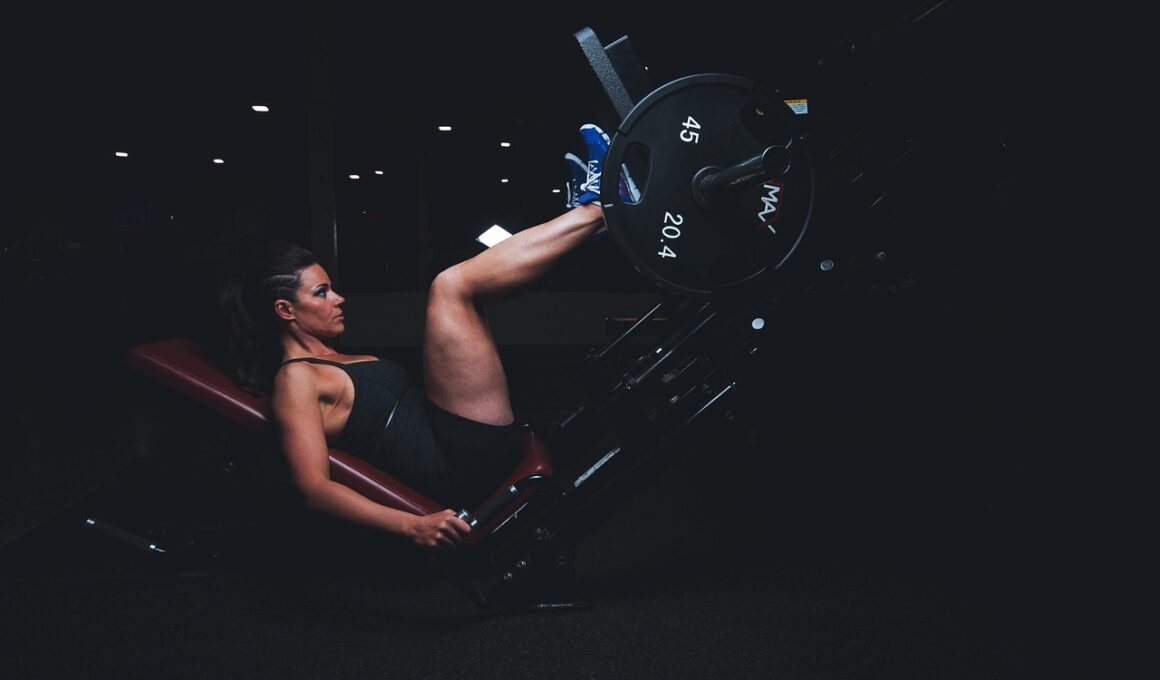Mistakes in Plyometric Workout Load Management
Plyometric workouts are incredibly effective for building strength and explosive power, but many athletes make common mistakes in load management. One significant mistake is not adhering to the principle of progressive overload, which is essential for long-term gains. Many people tend to increase the intensity and volume too quickly without allowing their bodies to adapt. This lack of gradual progression can lead to injuries or burnout. When implementing plyometric training, it’s vital to start with lower intensity exercises and systematically increase the load over time. For athletes to maximize their training results while minimizing injury risk, proper load management is crucial. Another common issue is the failure to incorporate rest days appropriately. Plyometric workouts place a high demand on the muscles and joints, necessitating adequate recovery time. Neglecting rest can thwart performance and lead to overtraining. Practicing good load management involves not only the right intensity but also ensuring sufficient rest periods between workouts. Listening to your body is key. Ignoring fatigue signals can extend the recovery process and diminish gains, counteracting the workout objectives. Avoiding these pitfalls will lead to more effective plyometric routines.
Another common mistake in plyometric training is neglecting the importance of proper technique. Many athletes rush into executing high-impact movements without mastering foundational skills. This oversight often leads to improper landings or take-offs that heighten the injury risk. Ensuring excellent form in basic exercises is vital before advancing to more complex plyometric drills. Proper technique maximizes efficiency and minimizes unnecessary strain on the joints and muscles. Using inadequate footwear can also contribute to poor performance and increased injury risk. Athletes should invest in shoes that provide adequate support and cushioning, which are specifically designed for plyometric training. This is critical in absorbing the stresses associated with high-impact landings. Furthermore, training without a proper warm-up or cooldown routine can exacerbate injury risks significantly. A thorough dynamic warm-up is essential to prepare the muscles, increase blood flow, and enhance mobility. Conversely, neglecting a cooldown routine can inhibit recovery and lead to muscle stiffness. Therefore, incorporating a proper warm-up and cooldown regimen complements plyometric workouts. Paying attention to technique and footwear is essential for injury prevention and optimizing training outcomes.
Ignoring Individual Differences
Ignoring individual differences in fitness levels and recovery capacities is a significant mistake athletes frequently make in plyometric training. Every athlete is unique, and their ability to handle stress varies greatly depending on their training history, body composition, and overall health. This means that a one-size-fits-all approach in workout programming may not apply to everyone. Customizing workouts according to individual capabilities helps enhance effectiveness and reduces the risk of injuries. Athletes must take into account factors like age, previous injuries, and physical fitness when determining their plyometric load. Moreover, individual differences in muscle fiber composition can affect how an athlete responds to plyometric training. Type II muscle fibers are better suited for explosive movements, while Type I fibers support endurance. Understanding these differences enables athletes and trainers to tailor plyometric exercises that align with individual athletic capabilities. Setting appropriate load management goals is vital for progression, and those goals need recalibration based on consistent assessments. Without considering these individual needs, progression can slow down, negatively impacting performance over time and possibly leading to mental fatigue or demotivation.
Another significant pitfall in plyometric workouts is the lack of specificities in exercise selection. Many athletes engage in jump training without understanding their unique sports requirements. Plyometric workouts should align closely with the functional movements inherent in an athlete’s specific sport. Choosing exercises that mimic the conditions and demands of their sport can yield significantly better results and maintain motivation. For example, a basketball player may benefit more from depth jumps and box jumps than generic squat jumps because of the sports-specific demands placed on their body. It is essential to analyze how strength and speed from plyometric training will translate into improved performance during competitions. Furthermore, neglecting to include exercises that address both horizontal and vertical power can cause imbalances in overall strength development. A well-structured plyometric routine should integrate various movements targeting different power outputs. This integration ensures a balanced training approach that maximizes overall athletic performance. The key to avoiding this pitfall lies in designing plyometric workouts that align with the functional necessities of the sport, ultimately enhancing performance and efficiency.
Overlooking Nutrition and Hydration
Overlooking nutrition and hydration is another mistake athletes make, which can negatively impact their plyometric training outcomes. Nutrition plays a fundamental role in recovery and performance, particularly in high-impact training like plyometrics. Consuming the right nutrients supports muscle repair and energy replenishment, essential for athletes performing explosive workouts. Athletes should prioritize a balanced diet rich in carbohydrates, proteins, and healthy fats. Carbohydrates provide the necessary energy fuel for explosive movements, while protein aids in muscle repair. Inadequate intake of these key nutrients can result in fatigue and diminish training effectiveness. Hydration is equally critical. During plyometric workouts, significant fluid loss occurs due to sweating, leading to decreased performance if not replenished. Athletes should regularly hydrate before, during, and after workouts to maintain optimal performance levels. Dehydration can adversely affect coordination and strength, significantly detracting from outcomes. Establishing good nutritional habits alongside effective plyometric training can maximize performance while enhancing recovery levels. Properly fueling and hydrating the body results in healthier athletes who are better prepared for the demands of plyometric workouts, ultimately enhancing training success.
Failing to monitor progress can also harm the effectiveness of plyometric workouts. Tracking performance metrics helps athletes understand their improvement areas and refine their training plans accordingly. Without monitoring parameters like jump height, speed, and overall strength, athletes risk stagnation or regress in their performance. Regular assessments allow for informed adjustments to accommodate growing strength and skill levels. Athletes must set measurable, progressive goals to foster motivation and maintain focus over time. Progress can be monitored through various methods, including using video analysis, fitness apps, or tracking records in training journals. Another common mistake is not implementing enough variety in plyometric training routines. Repeating the same exercises can lead to boredom and decreased motivation, while a lack of varied stimulus can slow progression. Incorporating alternative drills can maintain excitement while challenging different muscle groups and movement patterns. A balanced mix of familiar and novel exercises ensures athletes stay engaged and continuously challenged. By emphasizing progress monitoring and exercise variety, athletes can create more effective plyometric workouts tailored for sustained growth and athletic development.
Neglecting Periodization
Neglecting periodization in plyometric training plans is a significant error athletes should avoid for optimal performance. Periodization refers to the systematic scheduling of training intensity, volume, and recovery, ideally divided into macro, meso, and micro-cycles. Skipping this critical planning process often leads to burnout or plateaus, hindering progress over time. A well-structured periodization plan ensures athletes alternate between phases of intensity, allowing for recovery and adaptation. Without careful consideration of periodization, athletes may find themselves overtraining during heavy cycles, risking injury. Different phase lengths and intensities help prevent monotony in training, maintaining long-term motivation. Additionally, athletes must respect the transition between strength, speed, and power phases. These transitions should reflect the athlete’s specific performance goals and sport demands. Athletes will then reap the benefits of plyometric training while ensuring they do not encounter chronic fatigue or injuries that can arise from poorly managed training loads. By incorporating effective periodization strategies, athletes can navigate the complexities of plyometric training safely while optimizing performance gains.
In summary, effective load management in plyometric workouts involves avoiding common mistakes that could hinder progress or lead to injuries. Pay close attention to the principles of progressive overload, ensuring an adequate level of intensity while mindful of recovery needs. Additionally, it is essential to maintain proper technique, footwear, fueling, and hydration routines to support training demands. Recognizing individual differences in training capacities and personalizing workout plans will foster optimal results. Varied exercise selection targeting the sport’s specific movement demands should also be prioritized, while incorporating monitoring practices for assessing progress encourages sustained engagement. Understanding the need for periodization in training schedules will prevent burnout and promote proper adaptation. Focusing on these aspects creates a strong foundation for achieving the desired outcomes in plyometric training. Avoiding these common pitfalls not only enhances workouts but also contributes significantly to an athlete’s performance. Implementing the guidance provided can help you establish a comprehensive plan designed for sustainable success in plyometric workouts. Be analytical about your approach, adapt as necessary, and most importantly, listen to your body whenever adjusting training loads.


